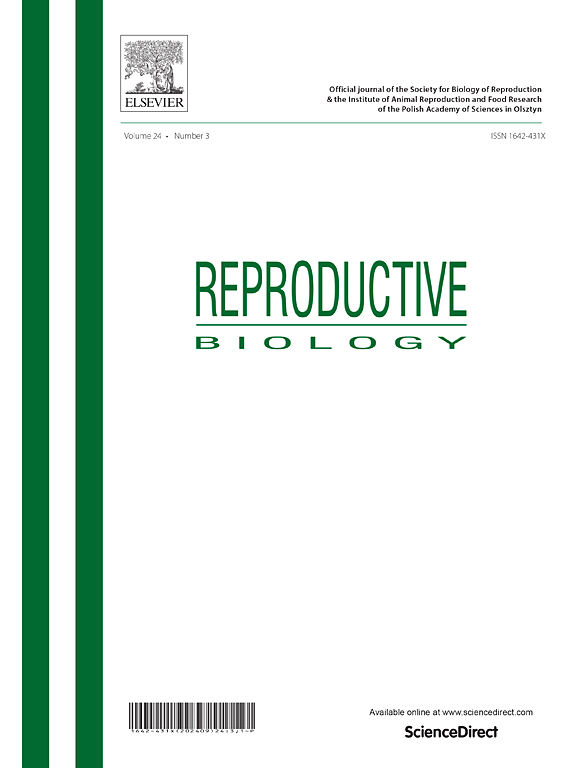白藜芦醇载固体脂质纳米颗粒对辐射或阿霉素诱导小鼠生精损伤的保护作用评价
IF 2.5
3区 生物学
Q3 REPRODUCTIVE BIOLOGY
引用次数: 0
摘要
辐射和阿霉素(Dox)对睾丸组织具有破坏性作用。白藜芦醇是一种天然的抗氧化剂,可以保护生精系统免受这些药物的毒性作用。本研究评估了白藜芦醇负载的固体脂质纳米颗粒(RES-SLNs)对Dox和辐射诱导的小鼠睾丸损伤的保护和抗氧化性能。在合成RES-SLNs并对其理化性质进行表征后,将60只成年雄性小鼠随机分为6组(每组 = 10只):对照组、RES-SLNs、Dox、辐射(Rad)、RES-SLNs + Dox和RES-SLNs + Rad。每组5只小鼠麻醉后切除双侧睾丸,测定丙二醛(MDA)和超氧化物歧化酶(SOD)水平。其余小鼠处死,进行睾丸组织病理检查。辐射和Dox给药显著增加MDA水平,降低SOD活性,改变组织学参数。相比之下,腹腔注射RES-SLN可显著降低MDA水平,增强SOD活性,减轻辐射或Dox引起的形态学改变。这些发现表明,res - sln可减轻辐射或Dox引起的睾丸氧化应激,从而防止严重的结构损伤。本文章由计算机程序翻译,如有差异,请以英文原文为准。
Evaluation of the protective effect of resveratrol-loaded solid lipid nanoparticles on radiation- or doxorubicin-induced spermatogenic damage in mice
Radiation and doxorubicin (Dox) exert destructive effects on testicular tissue. Resveratrol, a natural antioxidant, may protect the spermatogenic system against the toxic effects of these agents. This study evaluated the protective and antioxidant properties of resveratrol-loaded solid lipid nanoparticles (RES-SLNs) against Dox- and radiation-induced testicular injury in mice. Following the synthesis of RES-SLNs and characterization of their physicochemical properties, 60 adult male mice were randomly assigned to six groups (n = 10 per group): control, RES-SLNs, Dox, radiation (Rad), RES-SLNs + Dox, and RES-SLNs + Rad. Five mice from each group underwent anesthesia and bilateral orchiectomy for determination of malondialdehyde (MDA) and superoxide dismutase (SOD) levels. The remaining mice were sacrificed for histopathological evaluation of testicular tissue. Radiation and Dox administration significantly increased MDA levels, reduced SOD activity, and altered histological parameters. In contrast, intraperitoneal RES-SLN administration significantly lowered MDA levels, enhanced SOD activity, and mitigated morphological alterations induced by radiation or Dox. These findings indicate that RES-SLNs attenuate oxidative stress in the testes caused by radiation or Dox, thereby preventing severe structural damage.
求助全文
通过发布文献求助,成功后即可免费获取论文全文。
去求助
来源期刊

Reproductive biology
生物-生殖生物学
CiteScore
3.90
自引率
0.00%
发文量
95
审稿时长
29 days
期刊介绍:
An official journal of the Society for Biology of Reproduction and the Institute of Animal Reproduction and Food Research of Polish Academy of Sciences in Olsztyn, Poland.
Reproductive Biology is an international, peer-reviewed journal covering all aspects of reproduction in vertebrates. The journal invites original research papers, short communications, review articles and commentaries dealing with reproductive physiology, endocrinology, immunology, molecular and cellular biology, receptor studies, animal breeding as well as andrology, embryology, infertility, assisted reproduction and contraception. Papers from both basic and clinical research will be considered.
 求助内容:
求助内容: 应助结果提醒方式:
应助结果提醒方式:


